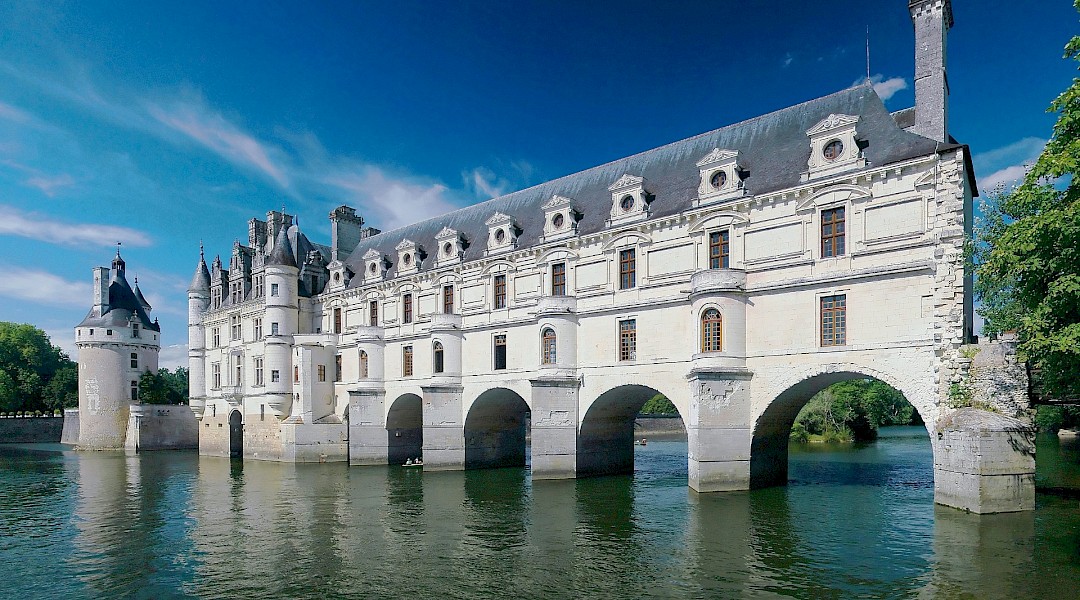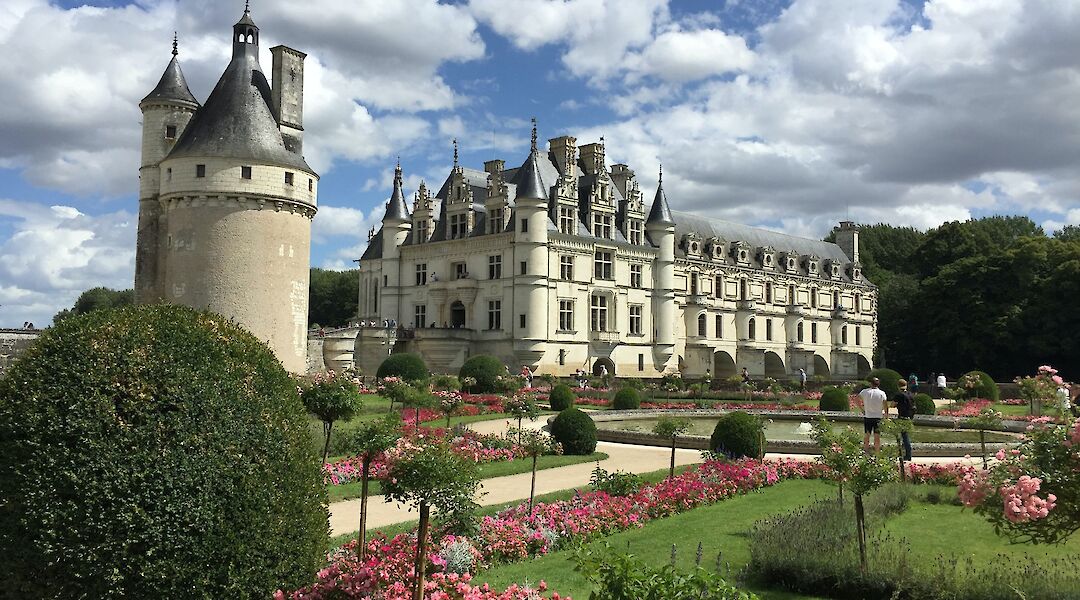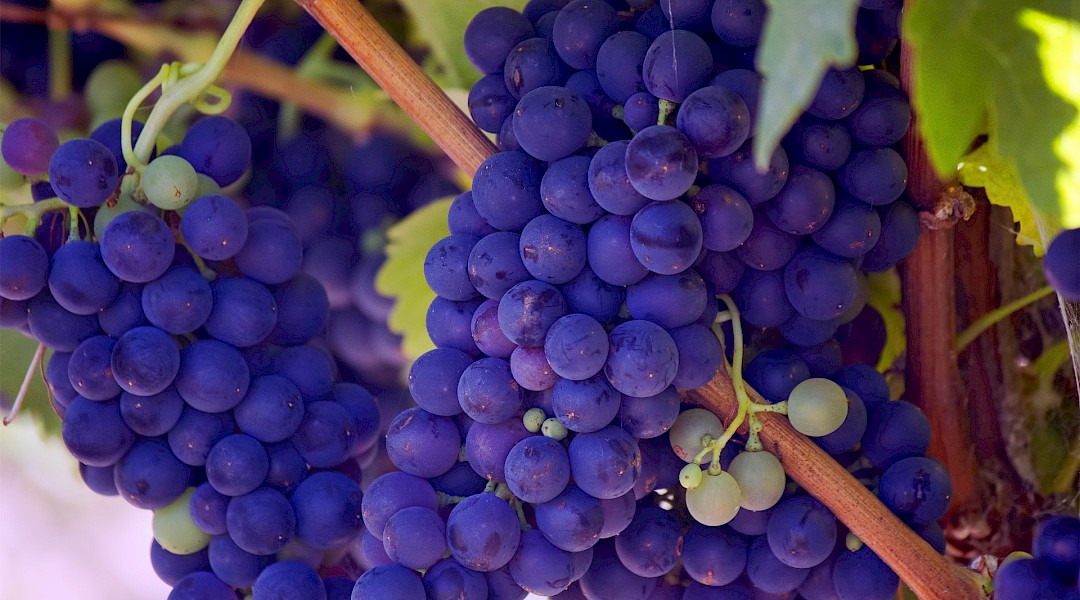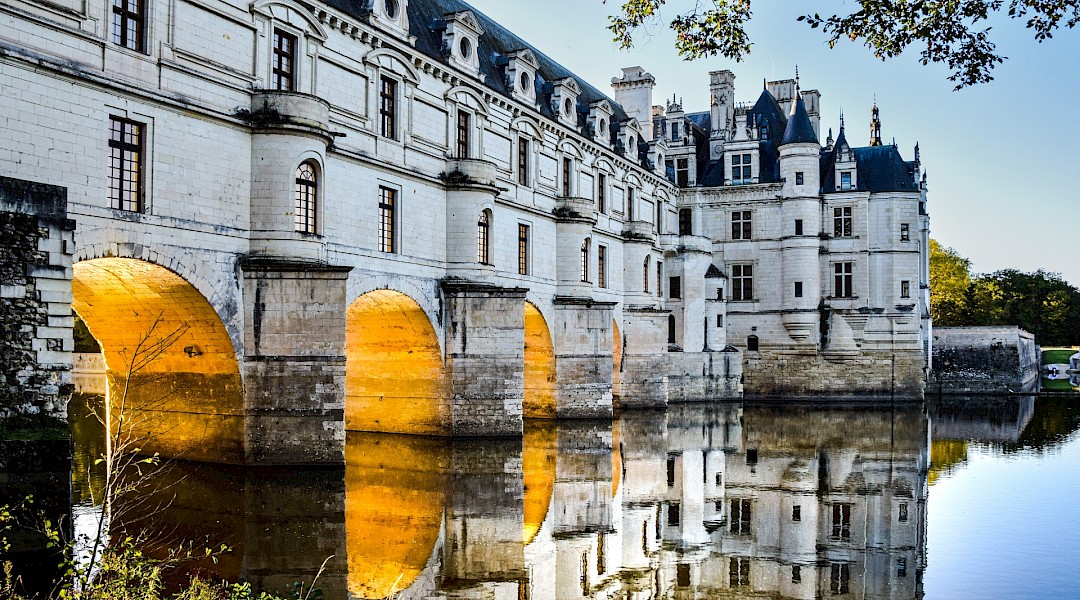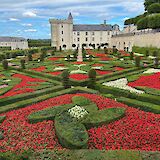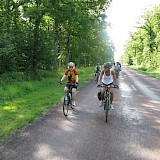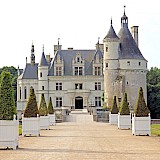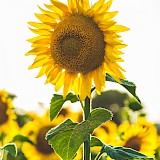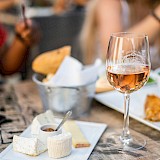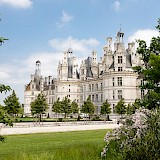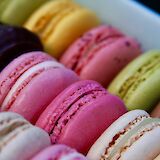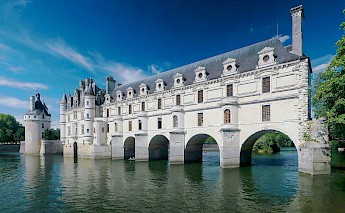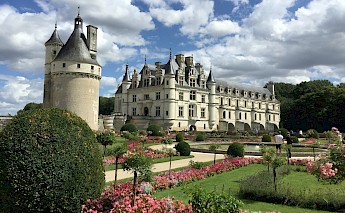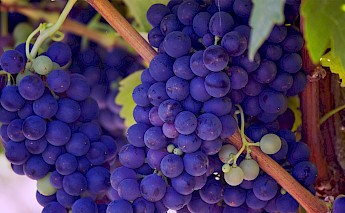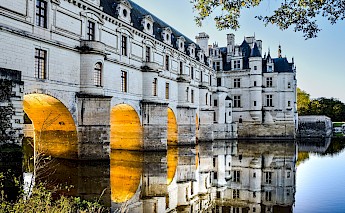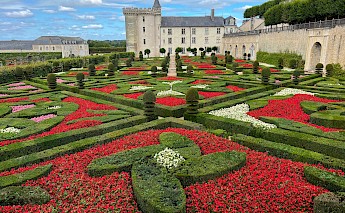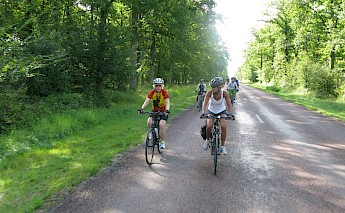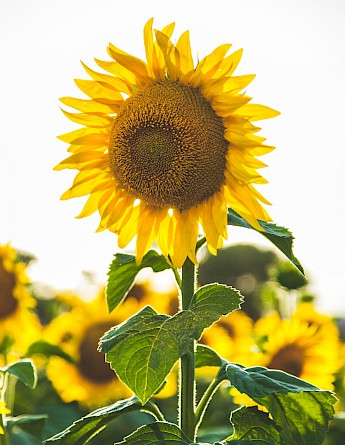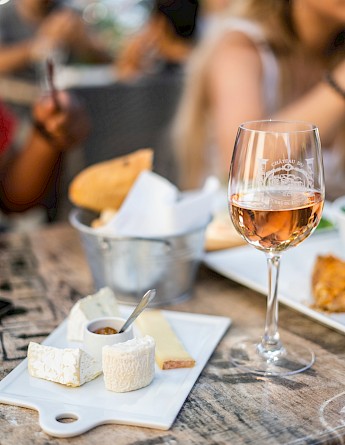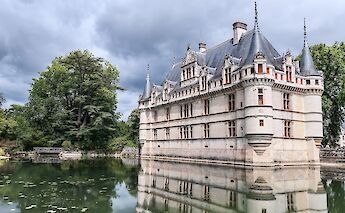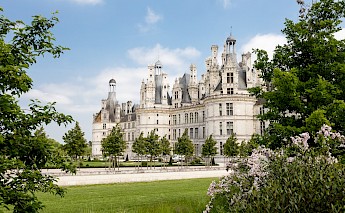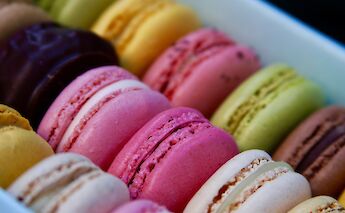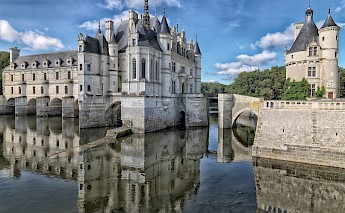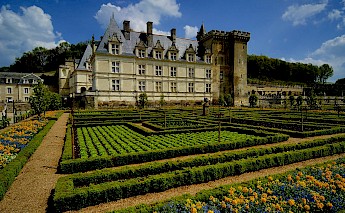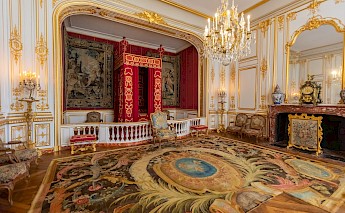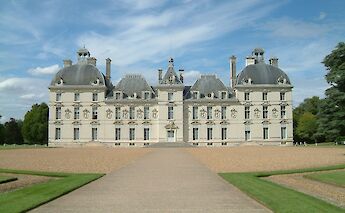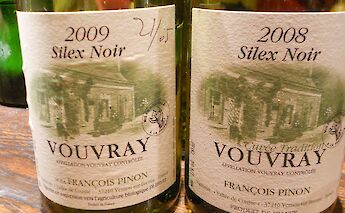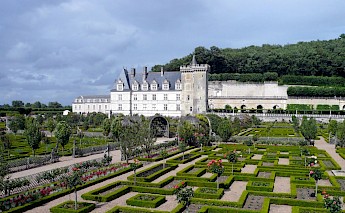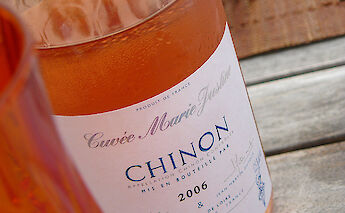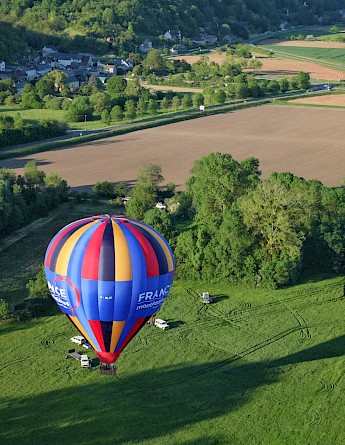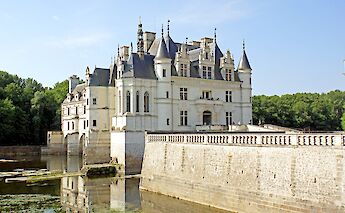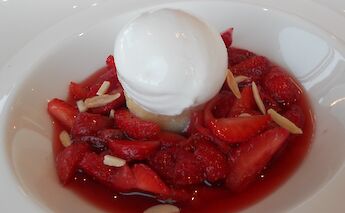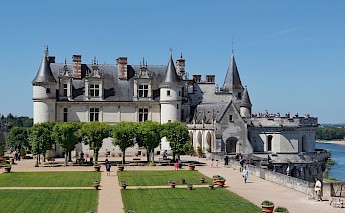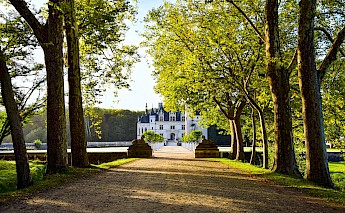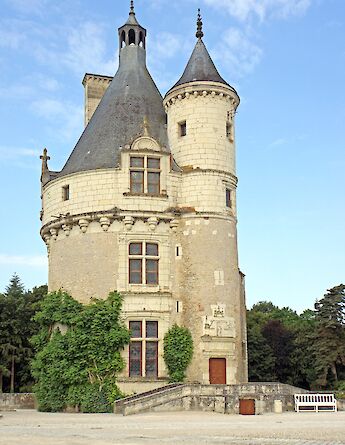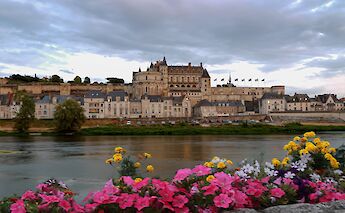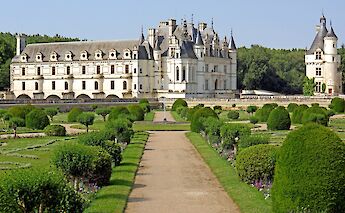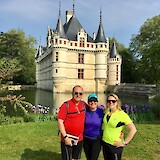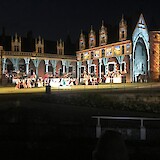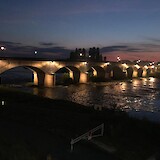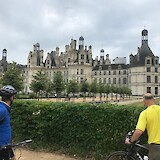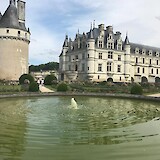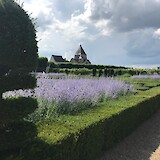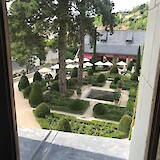Tap above to jump to different sections of this tour
-
Immerse yourself in the natural and architectural grandeur of the verdant Loire Valley
Between the 13th and the 16th Centuries, French royalty built a spellbinding collection of beautiful Renaissance chateaux. On this bicycle tour of the verdant Loire Valley, you will visit the spectacular Chateau Chambord - the largest of the Loire Valley chateaux - built by Francois I and boasting a spectacular staircase by Leonardo da Vinci. You'll visit Chenonceau, the former divine dwelling place of Diane of Poitiers, Henry II's mistress. Henry's mistress, Catherine de Medici, would evict Diane from the property before building the iconic ballroom across the River Cher.
These chateaux are stunning and the itinerary of visits is wonderful, accompanied by sumptuous food, delicate wines, and an exploration of a valley famed for its astonishing natural beauty.
Highlights
- Château de Chambord, with a staircase designed by Leonardo da Vinci
- Château de Chenonceau, the former home of Henry II's mistress
- Montreuil Bellay, a walled village
- Château de Brézé, a wine-making estate
- The Royal Abbey at Fontevraud, once home to many French queens
- Château d'Ussé
- Château d'Amboise
- Château d'Azay-le-Rideau
- Villandry and its beautiful gardens
- The Indre Valley, with its charming villages
- A visit to a traditional distillery
- Mushroom Caves at Bourre
- Château de Cheverny, amongst vineyards and winemakers
- The last home of Leonardo da Vinci at Clos-Luce
Learn More
Not sure whether to book a guided or self-guided tour? Learn about the differences between guided and self-guided tours.
Interested in adding to your itinerary? Take a look at our cycling day tours in the Loire Valley. -
Traveler photos
-
Daily program
Day 1: Arrival in Montreuil Bellay
You'll arrive at your lovely hotel in Montreuil Bellay by late afternoon. There'll be time to set up your bike and take it for a spin, but you are welcome to simply lounge by the pool and enjoy a cold pastis before dinner.Montreuil Bellay is an intriguing village, perched as it is inside its wall atop a hill which overlooks the Thouet River. The village, 15 km south of Saumur, boasts a beautiful chateau, which owns the hotel where you'll spend your first night.
Overnight in Montreuil Bellay.
Day 2: Montreuil Bellay – Chinon (30 miles/48 km)
Between Montreuil Bellay and your first splendid sight of the Loire Valley lies the Saumur-Champigny vineyard, rated by many as producing the finest red wine in the Loire. Today's first stop is Château Brézé, a wine-making estate most famous for its phenomenal underground chateau. Dating back to the 7th century, these troglodyte homes and villages are an incredible feature of this area. The limestone is so easily worked that it was easier to carve out a new room than to build one! One of the reasons behind the establishment of this underground chateau was to avoid the attention of invaders like the Vikings, with the whole chateau designed with defense in mind, including its moat, which is the deepest dry moat in Europe. The defensive structures at Château Brézé are fascinating. Most interestingly, it was never attacked, let alone defeated.Leaving Brézé, you'll make your way to the Royal Abbey at Fontevraud. This huge abbey was traditionally the home of many French queens and other royalty, but is most famous as the resting place of Henry II, his wife Eleanor of Aquitaine, and their son Richard the Lionheart. After lunch in Fontevraud, cycle on little roads to an off-road track that follows the river Vienne into Chinon.
In the 12th Century, Chinon was effectively the English capital as successive kings made their home in the chateau. It is much older than most Loire chateau, and its military purpose is obvious from its commanding position along the ridge that overlooks the medieval town of Chinon.
Overnight in Chinon.
Day 3: Chinon – Azay-le-Rideau (25 miles/40 km)
Today features fairly light cycling as you have a lot of chateau action to fit in! Begin with a tour of the castle of Chinon. As well as being home to English kings, the castle contains the tower where Joan of Arc heard the voices that told her she would be granted an army to relieve the siege of Orléans.You'll leave the Vienne and continue your cycling tour back towards the Indre and the Loire. Overlooking the Indre is the first of the big-league chateau - Château Ussé - reputedly the inspiration for the castle in Sleeping Beauty.
Next on your list is Villandry, an unexceptional chateau, but with gardens that Michelin rate as a 3-star attraction - "worth a journey in their own right". There are three gardens: a vegetable garden, a flower garden, and a water garden. Each year, the gardening team chooses a theme and tells a story in flowers. Villandry is really something, and not to be missed.
Overnight at Hotel des Châteaux, on the outskirts of Azay-le-Rideau.
Day 4: Azay-le-Rideau – Loches (35 miles/56 km)
In the morning, begin with a visit to one of the most beautiful chateaux of the Loire - Azay-le-Rideau. The little river Indre is dammed to surround the chateau on three sides and to create a beautiful lake and gardens.Leaving Azay, spend all day cycling along the Indre Valley, acclaimed as the most beautiful landscape of all the rivers of the Loire Valley. Cycle in quiet countryside as you make your way to Loches, home of the Royal City of Loches. Visit the Royal City tomorrow morning, just a stroll (albeit a steep one) away from tonight’s hotel, the George Sands.
Overnight in Loches.
Day 5: Loches – Montrichard (30 miles/48 km)
Today is a fabulous day. Begin at the Royal City, a short walk from the hotel. The Royal City consists of a Renaissance chateau as well as an older 'Donjon' - a traditional keep-style, much older chateau - used for much of its history as a prison.Loches is where Joan of Arc gatecrashed the Crown Prince of Valois, directed him to go to Reims, be crowned the King of France, and 'boot the English out of France'! Joan of Arc is incredibly important in France. She was a real figure - the stories of her relieving the siege of Orléans, and ordering Charles to become King are all true, and she was only 17!
Leave Loches and cycle along a narrow forest path and quiet roads to the Château of Chenonceau - the most visited of all the Loire chateau. Spanning the River Cher, and surrounded by ornamental gardens and man-made moats, this chateau is truly unforgettable. Most of the rooms are open, and this is a chance to see original floors, tapestries, and furniture. In general, French chateaux don't have all the furnishings and interior detail still visible. Chenonceau is a pleasant exception, and Louise of Lorraine's room, painted entirely in black with silver motifs of tears and crowns of thorns to mourn her dead husband, is especially memorable.
The ballroom, built by Catherine de Medici, spans the Cher in spectacular fashion, and although the chateau had no military value, it took on a gloomy historical role in the 20th century. First, it served as an army hospital in the First World War. Then, in the Second World War, the Cher was the boundary between Nazi-occupied France and Vichy France. Château Chenonceau was a border post, each end of the ballroom opening into a different country.
Your hotel tonight is the Hotel Bellevue in Montrichard, a few kilometers upstream from Chenonceau, overlooking the Cher.
Overnight in Montrichard.
Day 6: Montrichard – Chambord (35 miles/56 km)
A short ride beyond Montrichard leads you to the fascinating mushroom caves of Bourré where Blue Foot, Shitake, Oyster, and Paris mushrooms grow. Mushroom mycelia need a stimulus to prompt growth, whilst European mushrooms tend to need a light or heat stimulus. The shitake mushroom from Japan grows naturally on trees and responds to earth tremors common in that neck of the woods. Earthquakes are simulated in the caves using the state-of-the-art device of slapping the bin-liner that contains the mushroom compost. Result? Very many mushrooms! You'll find this stop fascinating. Bring something warm for a visit underground of around an hour.As well as mushrooms, there are a few spectacular galleries where you can see fantastic sculptures of local village scenes through the ages carved from solid rock. If you’ve never seen a sheet of paper carved in limestone before, complete with curled-up corners and the heads of nails pinning it to a wooden board (also carved in limestone, complete with wood grain), then you’re in for a treat.
The end of today is a favorite part of the whole week - the enormous Château Chambord. This is by far the largest of all the Loire chateaux and was originally built by Francois I as a hunting lodge. It lies inside a huge park contained by the largest wall in Europe (32 km). The chateau itself contains a famous double-helix staircase designed by Leonardo da Vinci, where two people can ascend or descend at the same time without meeting.
Your hotel tonight is the Hotel St. Florent, 10 km from the chateau in Mont-pres-Chambord.
Overnight in Chambord.
Day 7: Chambord – Amboise (35 miles/56 km)
The Loire cycle path into Amboise features a few hills, so be prepared for this. However, before that, you'll taste the wines at Vignoble Tevenot, a very traditional family winemaker in Cellettes, just on the edge of the enormous forests that surround Chambord.The final destination of your tour is Amboise, where the setting of the chateau overlooking the Loire is one of the most used images of the Loire valley. The town has a medieval center, largely pedestrianized, and full of bustle. There are a number of bars and cafes sitting directly beneath the huge chateau walls, and you've earned a sit-down and a glass of the local Touraine or Vouvray!
For anyone who hasn't visited Leonardo da Vinci's home at the Clos-Lucé, it's well worth it. Many of the original furnishings are still in place, including the great man's bed, and there is a permanent exhibition of his inventions and writings including several exquisite scale models. There are touching examples of his philosophy, and wonderful models of inventions that worked, like an ingenious water pump. Definitely worth visiting.
Tonight's stay is at the Hotel Vinci and dinner is at the Lion d’Or.
Overnight in Amboise.
Day 8: Departure
The TGV station at St. Pierre des Corps is only 20 minutes away, and if you booked the optional transfer, a gentle departure time of 10:30 am gets you back into Paris in the late morning for onward travel.Surface and terrain
The terrain for this tour is relatively flat, with average daily distances of 30 miles. You will cycle on quiet country roads for the most part.
Hotels
These are sample hotels and may vary by availability.
The accommodations on this tour are 2- and 3-star hotels. Hotels have been personally selected by the tour operator based on long-standing relationships and local charm and ambience.
Day 1: Relais du Bellay, Montreuil Bellay
Day 2: Hotel de France, Chinon
Day 3: Hotel des Chateaux, Azay-le-Rideau
Day 4: George Sand, Loches
Day 5: Hotel Bellevue, Montrichard
Day 6: Hotel St Florent, Chambord
Day 7: Hotel le Vinci, Amboise
Interested in visiting other areas before or after your tour? Visit our hotels page to learn more about lodging options.
How to get there
Tour start
Nearest airport: Tours, France
Nearest train station: Angers, FranceTour end
Nearest airport: Tours, France
Nearest train station: St. Pierre des Corps, FranceMost participants prefer to travel from London or Paris via the TGV or high speed train.
Optional Transfers
For an extra cost, you can book various optional transfers to the tour start and back from the tour end. Transfers include, as necessary: Eurostar, TGV, and/or local transfers and are priced per person for the round-trip, which means it includes transfer to the tour start on Day 1 and from the tour end on Day 8.Please take careful note of the train times below. Our local transfers are scheduled to meet these designated trains; if these train times are inconvenient, please contact us so that we can be sure of arranging appropriate transfers.
From London
If you book the 'From London' transfer, it includes both Eurostar and TGV tickets and local transfers. Please note, there is a change of trains in Lille Europe. Local transfers are from Angers station to the first hotel and from the last hotel to St. Pierre Des Corps station.Day 1
Depart London Pancras International: 10:57 am
Arrive Angers: 17:12 (5:12 pm)Day 8
Depart St. Pierre Des Corp: 11:01 am
Arrive London Pancras International: 16:03 (4:03 pm)From Paris, Montparnasse
This transfer includes TGV tickets and local transfers. Local transfers are from Angers station to the first hotel and from the last hotel to St. Pierre Des Corps station.Day 1
Depart Paris Montparnasse: 15:52 (3:52 pm)
Arrive Angers: 17:25 (5:25 pm)Day 8
Depart St. Pierre Des Corps: 11:19 am
Arrive Paris Montparnasse: 12:24 pmFrom Paris, Charles de Gaulle Airport
This transfer includes TGV tickets and local transfers. Local transfers are from Angers station to the first hotel and from the last hotel to St. Pierre Des Corps station.Day 1
Depart Charles de Gaulle: 14:48 (2:48 pm)
Arrive Angers: 17:12 (5:12 pm)Day 8
Depart St. Pierre Des Corps: 11:01 am
Arrive Charles de Gaulle: 12:39 pmLocal Transfers
Local transfers are from Angers station to the first hotel and from the last hotel to St. Pierre des Corps station. Please note that the arrival and departure stations are different.You can also book transfer round-trip from and to the Tours airport.
Tips on getting to and from your tour.
-
Dates
Jun 17*, Jul 15, Aug 19, 2023 (*indicates fully booked departure)
Prices
Tour package
Per person, double occupancy US$2110 Single use room(1 person/1 room) US$2570 Bike Rentals
E-bike US$150 Transfer
From Angers train station and to Pierre des Corp train station, round-trip per person US$95 Tours airport, round-trip per person US$225 Included services
- 7 nights accommodation
- 7 breakfasts and evening meals (dinners)
- Luggage transfers each day
- Tour guide
- Emergency contact number
- Bike rental, including fitting and setup
- Basic bicycle repair kit and equipment
- Waterproof jacket and Chain gang cycling jersey
- Comprehensive route book, route notes, and maps
Bike rentals
Bikes available on this tour, and included in the tour cost (reserved in advance at the time of booking):
- Standard touring bikes, Trek FX 3, Shimano Nexave
Bikes available on this tour for an additional fee (reserved in advance at the time of booking):
- Electrically-assisted bikes*
*More about electrically-assisted bikes >
Bikes come equipped with:
- Helmets
- Waterproof jackets and cycling jersey
- Panniers
- Water bottle
- Basic repair kit
Pedals:
The bikes will have flat pedals. If you bring your own pedals, be sure to bring your own shoes.Helmets:
Helmets are available on this tour. However, we recommend that you bring your own helmet for safety and hygiene purposes.Bike Protection:
Bike protection can be purchased at the time of booking. You can read more about that HERE.
-
Route Map
Maps are for information purposes only and reflect typical routes between overnight locations. They may not reflect your actual route.
-
Reviews
-
★★★★★ Cindy Kinney November 8, 2022
Great way to discover France
We had a knowledgeable guide that helped us experience the beauty of France. We enjoyed the food, wine and people. Great biking and a wonderful adventure.
The gardens were amazing and the history of the area was fascinating.
- What was the date of your tour?
- September 2022
- How many tours have you completed?
- 3
- Difficulty (actual vs. expected)?
- As expected
- Who is this tour suitable for?
- First-time bike tourists, Solo travelers, Families with teens
- Do you recommend this tour?
- Yes
-
★★★★★ Becky Foster October 11, 2022
Loire Valley - Bike Trip you Want to Take!
This was a great choice for a bike trip! The roads are narrow and beautiful, but the drivers in France are incredibly patient. Each day we saw one or two chateaux. They are all quite different from one another, so I loved visiting every one! Our guide, Sam, was fantastic. He was personable and encouraged each of us in the way we needed. We upgraded to two chateaux and I would highly recommend doing that.
- What was the date of your tour?
- Sept/Oct 2022
- How many tours have you completed?
- 3
- Difficulty (actual vs. expected)?
- Somewhat easier
- Do you recommend this tour?
- Yes
-
★★★★★ Ellen Hatfield October 10, 2022
Great trip!
This trip was a great way to explore the Chateaus of the Loire Valley. The trip was over nice roads and was very scenic. We were a returning group with experienced riders, so we had a lot of fun and traveled at a good pace. Our guide, Sam Taylor, really made the trip. He was fun, engaged with us, knew his stuff and can change a tire at a remarkable pace. He is a fantastic guide.
The only thing I would recommend is having the chateau tours included in the tour price. It was a real hassle having to get tickets for a large group at the site. I guess I thought the tickets were included in the tour. We had someone from our group pay for the tickets, but then we had to do a money exchange everyday which was a pain.
I also thought some wine was included but we could get more if we wanted. We paid for- What was the date of your tour?
- Sept 2022
- How many tours have you completed?
- 2
- Difficulty (actual vs. expected)?
- As expected
- Do you recommend this tour?
- Yes
-
★★★★★ Kathleen Cook October 5, 2022
Fantastic Trip
This trip was even better than expected. The riding was enjoyable. The routes were mostly flat and lightly traveled roads or bike paths. Our guide, Sam, was very knowledgeable and personable. Hotels and meals were great too. We upgraded two hotels. A+
- What was the date of your tour?
- September-October 2022
- How many tours have you completed?
- 5
- Difficulty (actual vs. expected)?
- As expected
- Who is this tour suitable for?
- First-time bike tourists, Solo travelers, Families with teens
- Do you recommend this tour?
- Yes
-
★★★★★ Lindynw July 15, 2019
A Wonderful Tour of the Loire Valley Chateaux
This tour exceeded our expectations. First we wish to extend a huge thank you to Bernard and Lydia for agreeing to guide this tour even though we were the only 2 people who signed up for it. That was most generous and gracious. Bernard is knowledgeable, funny, and very kind. His guide-in-training, Lydia, who accompanied us added an extra amount of fun and was very willing to help with French translations. We feel very fortunate to have been on her first tour and know she will succeed in her future guided trips. Although our group was small we immensely enjoyed the hotels, the wonderful food and wine, the picnics, and the chateau visits. We were sad to have the trip come to an end. We highly recommend this trip and feel it is the best way to experience the chateaux of the Loire Valley.
- What was the date of your tour?
- June 29, 2019
- How many tours have you completed?
- 2
- Difficulty (actual vs. expected)?
- As expected
- Who is this tour suitable for?
- Solo travelers, First-time bike tourists, Families with teens
- Do you recommend this tour?
- Yes
-
★★★★★ Tonzo June 9, 2019
The Loire Valley Chateau and Garden Tour
What a wonderful experience and a lovey biking trip. So enjoyed our guide Bernard and his vast knowledge of the area. The accommodations were excellent and the food was great. What more can I say other than my husband and I had a great time.
- What was the date of your tour?
- May 18-25
- How many tours have you completed?
- 5
- Difficulty (actual vs. expected)?
- As expected
- Who is this tour suitable for?
- Solo travelers, First-time bike tourists, Families with teens
- Do you recommend this tour?
- Yes
-
★★★★★ Rob4056 June 6, 2019
Just right!
A wonderful combination of sights, food, friends and fun! Bernard was the consummate host, helping us through the markets to buy group picnic lunches that everyone loved, finding routes that were uncrowded with traffic and scenic, answering all questions and smoothing out any bumps with a smile. The hotels were just right - comfortable and not too fancy given that we were only there to sleep. Bikes and equipment (rain gear, panniers, etc.) were excellent, and Bernard had the skills and carried the tools necessary to fix anything that wasn’t quite right. And the chateaus were stunning, as were the countryside and small villages along the way. May was a perfect time - dealing with summer crowds and heat would have been less fun. Occasionally we felt a bit rushed going through a large chateau, but we saw the highlights, and there were always many more things waiting for us down the road - like the small winery where the owner explained her many challenges and the cave which grows amazing mushrooms. And every day was capped off by a wonderful dinner, good wine and great conversation. Thank you Bernard and tour organizers for a wonderful trip!
- What was the date of your tour?
- May 2019
- How many tours have you completed?
- 1
- Difficulty (actual vs. expected)?
- As expected
- Who is this tour suitable for?
- Solo travelers, First-time bike tourists, Families with teens
- Do you recommend this tour?
- Yes
-
★★★★★ JaneN June 5, 2019
The Perfect Bike Tour
There was no guided Loire Valley Chateaux and Gardens Tour scheduled by the local tour operator in May 2019, which is when our group wanted to go. We asked, and the tour operator was happy to add our requested week since we were a group of 8.
In summary, the tour and guide exceeded our expectations and hopes.
May is a fabulous time to do this tour. The high temperatures were generally in the mid-60s (about 18 degrees C), perfect for riding, there were only a couple of times when we had very light rain for a couple of hours. The wild flowers and garden flowers are in full bloom and everything else is fresh and green as it is in mid-spring. This was prior to the start of the heavy tourist season, so traffic is lighter than in July and August.
Our tour guide was wonderful. He gladly accommodated a couple of special needs. He focused on giving us a local experience in the accommodations, food, sightseeing, and bike paths we never would have found on our own. While we were frequently on roads where cars could go, these were roads used mostly by local farmers or workers and there was almost no traffic. Frequently we were on bike/pedestrian only paths. Almost of the surfaces were paved and the few packed dirt paths easy for bicycles. Bernard gave us loads of information about the villages and sights we saw, the local history, and what is going on in the Loire Valley today.
The accommodations are very nice in that you stay in small 2- or 3-star hotels with character and charm run by independent owners. Breakfast was always varied and hearty enough for a good start to the day. Dinners were very good at selected restaurants that highlighted the wonderful and varied local cuisine. We frequently did picnics for lunch (not included in the tour cost), which is what our group preferred, and our guide steered us to local products which were fresh and excellent.
The bikes were in great condition, and we had confidence that our tour guide could readily fix anything that might go wrong along the way.
- What was the date of your tour?
- 18-25 May 2019
- How many tours have you completed?
- 3
- Difficulty (actual vs. expected)?
- Somewhat easier
- Who is this tour suitable for?
- Solo travelers, First-time bike tourists, Families with teens
- Do you recommend this tour?
- Yes
-
★★★★★ Rosie1633 June 1, 2019
Fabulous tour!
We thoroughly enjoyed our Loire Valley bike trip! We could not have had a better guide! He was attentive, incredibly knowledgeable, kind and funny. He even stopped to help another cyclist along the way who had a broken spoke. There was just the right amount of cycling, touring and eating. Our group is already making plans to do another trip next year in Europe.
- What was the date of your tour?
- May 18-26, 2019
- How many tours have you completed?
- This was my first
- Difficulty (actual vs. expected)?
- As expected
- Who is this tour suitable for?
- Solo travelers, First-time bike tourists, Families with teens
- Do you recommend this tour?
- Yes
-
★★★★★ Cornelia July 22, 2018
Absolutely wonderful trip with a tour guide extraordinaire!
I base most of my "Excellent" ratings on our guide, Bernard Dugdale, from The Chain Gang Tour Company via Bike Tours. He provided an excellent and problem-free bike trip for all 13 people on this Loire Valley Tour. He even pulled a rabbit out of a hat and secured train tickets for us while there was a train strike in France. He made sure everyone's bike "fit" them and was comfortable in every way. He was fluent in French, a lot of fun, and seemed to have his finger on the "pulse" of what was going on with each and everyone of us and made sure we were all looked after, whether ordering in a restaurant or having a minor difficulty with our bike. The castles were stunning and scenery beautiful. A+
- What was the date of your tour?
- June 30-July 6, 2018
- How many tours have you completed?
- 2
- Difficulty (actual vs. expected)?
- As expected
- Who is this tour suitable for?
- Solo travelers, First-time bike tourists, Families with teens
- Do you recommend this tour?
- Yes
-
★★★★★ Arti July 22, 2018
Everything expected
Could not have duplicated the selection of hotels, restaurants, company, explanations, detailed trails, cultural explanations.
- What was the date of your tour?
- 6/30/2018 to 7/7/2018
- How many tours have you completed?
- 0
- Difficulty (actual vs. expected)?
- As expected
- Who is this tour suitable for?
- Solo travelers, First-time bike tourists, Families with teens
- Do you recommend this tour?
- Yes
-
★★★★★ Jack Luther December 12, 2017
Slow and Easy Cycling the Loire Valley
In the fall of 2016 my wife and I went on this adventure. This was our second Bike Tours vacation and again it exceeded our expectation in every way. Each day we enjoyed beautiful scenery and toured amazing chateaux followed by an evening relaxing with exceptional wines and cuisine in small French villages. As always the trip ended all too soon but the video I made and posted here helps us relive one of our best vacations ever.
- What was the date of your tour?
- September 2016
- How many tours have you completed?
- Three with Bike Tours. com
- Difficulty (actual vs. expected)?
- As expected
- Who is this tour suitable for?
- Families with teens
- Do you recommend this tour?
- Yes
Video: Cycling in the Loire Valley
-
BikeTours.com staff reply from Brittany December 13, 2017
Jack, we're so glad to hear that you and your wife had such a great time on tour! Your video puts me in the valley immediately. We hope to help you with your next tour and thanks for taking the time to review.
-
★★★★★ Coasters September 18, 2017
A glimpse of the Loire valley
A fabulous way to experience the countryside around the Loire valley. GPS maps made this trip very pleasurable
- What was the date of your tour?
- Sept 11-17
- How many tours have you completed?
- 5
- Difficulty (actual vs. expected)?
- As expected
- Who is this tour suitable for?
- Solo travelers, First-time bike tourists, Families with teens
- Do you recommend this tour?
- Yes
-
★★★★★ Roadbiker August 9, 2017
Self guided Loire Valley Ride
- What was the date of your tour?
- July 23-29
- How many tours have you completed?
- First bike tour
- Difficulty (actual vs. expected)?
- Somewhat harder
- Who is this tour suitable for?
- Solo travelers
- Do you recommend this tour?
- Yes
-
★★★★★ travelprodtw October 18, 2016
Lovely week in the Loire Valley
The perfect time to go on this tour is shoulder season; would be much too hot in the summer months; especially since some hotels did not have A/C. The local operator had great bikes (Treks) but we did experience a wheel problem on day 1 which they were not quick enough to address (we were on a self-guided tour). It was as if they did not believe us when we reported the problem. We had to be insistent they address it on day two rather than them wanting to take care of the problem. In all it cost us about 3 hours delay the first day and 2 hours on Day 2; missed two chateau visits as a result Loved the unusual routing for the tour but since it was off the beaten bike path, could have used more precise directions and maps. It would help if they said something like "After 3.2 miles go right on the gravel road" instead of "then take A32 right" because there was not always a sign for "A32".
- What was the date of your tour?
- September 2016
- How many tours have you completed?
- 2
- Difficulty (actual vs. expected)?
- As expected
- Who is this tour suitable for?
- First-time bike tourists, Families with teens
- Do you recommend this tour?
- Yes
-
BikeTours.com staff reply from Lindsay Nash October 19, 2016
Hi, thanks very much for sharing your experience. We're glad you had a lovely week in the Loire Valley. It's truly a beautiful place.
We're sorry to hear of the trouble with the bikes, especially since you missed out on the chateaux visits. As an apology from us, we'd love to waive your booking fees on your next tour. Please just mention this next time you book!
Thank you again for sharing your experience, which we will share with the local operator as we continually work to improve our offerings and services.
Kind regards,
Lindsay
-
